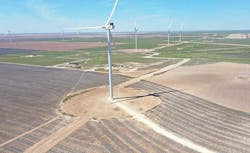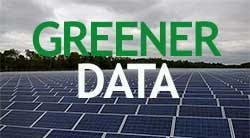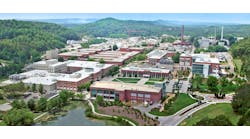On Earth Day 2020, the data center industry is focusing on sustainability as never before, with the executive suite and customers aligned on the importance of using renewable energy to power digital infrastructure.
“The data center industry underpins the growth of the digital economy, and we believe it is critical for industry participants to recognize the importance of managing the environmental impact of their digital infrastructure,” said William Stein, the CEO of Digital Realty, which today announced a major purchase of wind energy to support its data centers.
The most significant trend is that the demands for a greener cloud are coming from customers, not just operators and Greenpeace. Over the last six months, Data Center Frontier has tracked the conversation about sustainability across multiple industry events, which has reflected a much more prominent role for the customer perspective.
“The green story of our data centers is becoming much more important for our customers,” said Jaime Leverton, Chief Commercial Officer at eStruxture Data Centers.
“We’re seeing consumers and builders deciding to put sustainability in first,” said Craig Scroogie, CEO and Managing Director of NextDC, one of Australia’s leading data center providers.
“Renewable energy is becoming a prerequisite,” said Gil Santaliz, the President and CEO of the NJFX data center in Wall, N.J. “If you can’t get hold of renewable energy, you’ll be at a disadvantage.”
Hyperscale Players Make Huge Green Power Deals
That kind of alignment signals the growing recognition of climate risk as a business concern. Enterprise support for renewably-powered data centers has historically lagged the commitments seen by major hyperscale operators, who have led the push to slash dependence on fossil fuels. In 2019, the four largest hyperscale operators procured 3.76 gigawatts of renewable energy using power purchase agreements (PPAs).
Source: Renewable Energy Buyers Alliance
- In January Microsoft unveiled an aggressive plan to cut its carbon emissions in half by 2030, both for direct emissions and its entire supply and value chain. “By July of 2021, we will begin to implement new procurement processes and tools to enable and incentivize our suppliers to reduce their emissions,” the company said.
- Facebook was the single largest purchaser of renewable energy in 2019, lining up 1.54 gigawatts of wind and solar energy to support its data centers through PPAs. Procuring local sources of renewable energy is now a key factor in how Facebook selects its new data center campuses.
- Google continues to be one of the largest corporate purchasers of green energy, as well as a pioneer in saving energy through data center efficiency. Google said today unveiled a carbon-intelligent computing platform that can reduce the carbon impact of its massive data center network, shifting large computing jobs to times where they can be powered with renewable energy.
- Amazon Web Services, which has come under fire for lagging other cloud leaders on renewables, has committed to meet the terms of the Paris Agreement 10 years early, reaching net carbon zero operations by 2040. While Amazon did not provide details, those goals cannot be met without a major acceleration of renewable energy purchases to support Amazon Web Services.
Over the past several years, the hyperscalers have been joined in earnest by the largest multi-tenant data center providers. Today Digital Realty announced a new 7.5-year power and renewable energy credit agreement with Citi to supply wind energy for Digital Realty’s 13 data centers in the Dallas area, equivalent to about 30 percent of the power needs in the Dallas market. The deal provides Digital Realty with over 260,000 megawatt-hours of renewable energy annually from the Bearkat Wind Energy II project on Glasscock County, Texas.
The wind power agreement builds on Digital Realty’s green strategy. In 2019, the company announced an additional 50 megawatts of renewables to support its data centers in Ashburn, Virginia and signed a green tariff agreement with Portland General Electric to supply approximately 120,000 megawatt-hours annually to a new project in Hillsboro, Oregon.
Multi-tenant data center developers like Switch, Digital Realty, Aligned and Iron Mountain have also lined up green energy for their data center clients.
Embracing a Leadership Role in Sustainability
While hyperscale data center operators have been leaders in renewable energy purchasing, they’ve also been under scrutiny from the environmental group Greenpeace, which has noted the industry’s progress but continues to single out providers and utilities that it believes are not keeping pace.
This attention will not go away, and some data center executives say the sector needs to acknowledge its crucial role in the transition to a cleaner economy.
“Our whole industry ethos will be judged over the next five years,” said Bruno Lopez, Group CEO and Director of ST Telemedia Global Data Centres, based in Singapore. “We are becoming a lightning rod, and building data centers the same way is not an option anymore. We have to build more sustainable solutions. Using renewables is going to be the way forward.”
Some data center thought leaders say the industry needs to do a better job telling the story of its role in the green power economy.
“On the sustainability side, the data center industry gets a lot of knocks,” said Lee Kestler, the Chief Commercial Office for Vantage Data Centers, which has made sustainability a key theme in its recent data center designs. “We are driving a lot of opportunities for investment in the renewable energy side.”
Now that scrutiny will also apply to the supply chain.
“Everyone’s seen the announcement Microsoft has made,” said Dana Adams, the Chief Operating Officer of AirTrunk. “hey will be pressing their supply chain to deliver on this.”
Microsoft’s commitment includes a commitment to invest $1 billion in carbon remediation technologies over the next four years.
“We see an acute need to begin removing carbon from the atmosphere, which we believe we can help catalyze through our investments,” said Microsoft President Brad Smith. “We will achieve this through a portfolio of negative emission technologies (NET) potentially including afforestation and reforestation, soil carbon sequestration, bioenergy with carbon capture and storage (BECCs), and direct air capture. Given the current state of technology and pricing, we will initially focus on nature-based solutions, with the goal of shifting to technology-based solutions between now and 2050, when they become more viable.”







